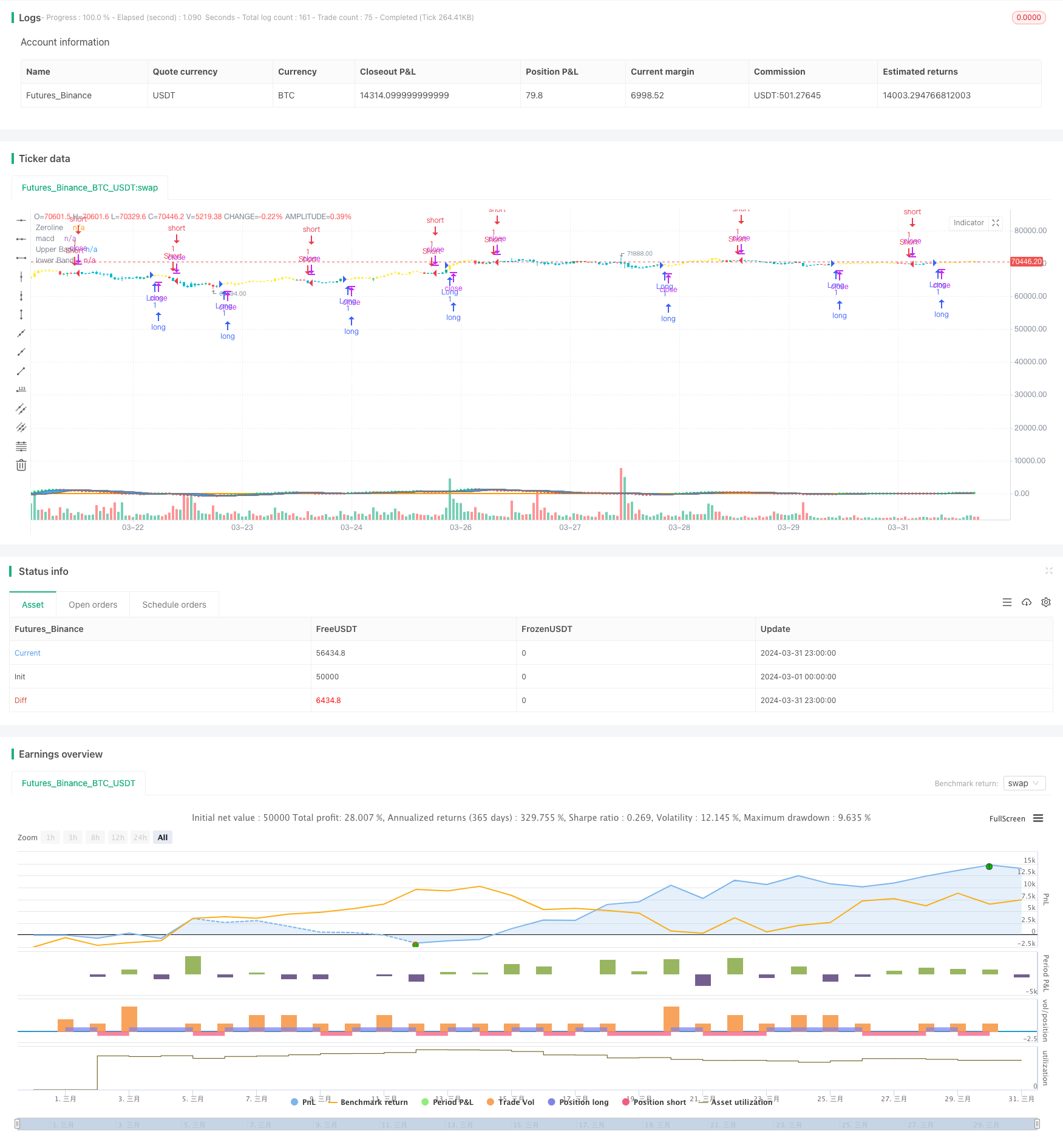MACD BB Breakout Strategy
Author: ChaoZhang, Date: 2024-04-25 17:16:28Tags: MACDEMABBSMA

Overview
The MACD BB Breakout Strategy is a trading strategy based on the MACD indicator and Bollinger Bands. The strategy utilizes the MACD indicator to capture short-term market trends while using Bollinger Bands to determine overbought and oversold areas in the market. When the MACD indicator breaks above the upper Bollinger Band, the strategy enters a long position; when the MACD indicator breaks below the lower Bollinger Band, the strategy enters a short position. The strategy aims to capture short-term market trends and initiate trades in the early stages of trend formation.
Strategy Principle
The principle of the MACD BB Breakout Strategy is as follows: 1. Calculate the MACD indicator: Use a fast Exponential Moving Average (EMA) and a slow EMA to calculate the MACD indicator. 2. Calculate Bollinger Bands: Use the Simple Moving Average (SMA) of the MACD indicator and standard deviation to calculate the upper and lower Bollinger Bands. 3. Long signal: When the MACD indicator breaks above the upper Bollinger Band, the strategy enters a long position. 4. Short signal: When the MACD indicator breaks below the lower Bollinger Band, the strategy enters a short position. 5. Take Profit and Stop Loss: The strategy can set take profit and stop loss percentages to manage trading risk.
Strategy Advantages
- Trend Capture: The MACD indicator can effectively capture short-term market trends, allowing the strategy to initiate trades in the early stages of trend formation.
- Volatility Consideration: Bollinger Bands take into account price volatility, helping the strategy avoid false trading signals during increased market volatility.
- Parameter Flexibility: The strategy’s parameters, such as the MACD fast and slow period, Bollinger Bands period, and standard deviation multiplier, can be optimized and adjusted based on market characteristics.
Strategy Risks
- Drawdown Risk: The strategy enters trades in the early stages of trend formation, which may expose it to significant drawdown risk.
- Frequent Trading: If the parameters are not set properly, the strategy may generate excessive trading signals, leading to frequent trading and high transaction costs.
- Parameter Optimization: The strategy’s performance depends on the selection of parameters, and inappropriate parameters may result in poor performance.
Strategy Optimization Directions
- Trend Confirmation: After generating a trading signal, additional indicators or price action can be used to confirm the validity of the trend, filtering out some false signals.
- Dynamic Stop Loss: Adjust the stop loss position dynamically based on market volatility or price action to better control risk.
- Parameter Adaptation: Utilize machine learning or optimization algorithms to achieve adaptive adjustment of strategy parameters to adapt to different market conditions.
Summary
The MACD BB Breakout Strategy combines the MACD indicator and Bollinger Bands to initiate trades in the early stages of trend formation. The strategy’s strengths lie in its ability to capture short-term trends and consider price volatility. However, it also faces challenges such as drawdown risk, frequent trading, and parameter optimization. Through trend confirmation, dynamic stop loss, and parameter adaptation, the strategy’s robustness and adaptability can be further enhanced.
/*backtest
start: 2024-03-01 00:00:00
end: 2024-03-31 23:59:59
period: 1h
basePeriod: 15m
exchanges: [{"eid":"Futures_Binance","currency":"BTC_USDT"}]
*/
//@version=5
//AK MACD BB
strategy("AK MACD BB strategy", overlay = true)
// Inputs for TP and SL
tp_percent = input.float(1.0, title="Take Profit %") / 100
sl_percent = input.float(1.0, title="Stop Loss %") / 100
length = input.int(10, minval=1, title="BB Periods")
dev = input.float(1, minval=0.0001, title="Deviations")
//MACD
fastLength = input.int(12, minval=1, title="fastLength")
slowLength=input.int(26,minval=1)
signalLength=input.int(9,minval=1)
fastMA = ta.ema(close, fastLength)
slowMA = ta.ema(close, slowLength)
macd = fastMA - slowMA
//BollingerBands
Std = ta.stdev(macd, length)
Upper = (Std * dev + (ta.sma(macd, length)))
Lower = ((ta.sma(macd, length)) - (Std * dev))
Band1 = plot(Upper, color=color.gray, style=plot.style_line, linewidth=2,title="Upper Band")
Band2 = plot(Lower, color=color.gray, style=plot.style_line, linewidth=2,title="lower Band")
fill(Band1, Band2, color=color.blue, transp=75,title="Fill")
mc = macd >= Upper ? color.lime:color.red
// Indicator
plot(macd, color=mc, style =plot.style_circles,linewidth = 3, title="macd")
zeroline = 0
plot(zeroline,color= color.orange,linewidth= 2,title="Zeroline")
//buy
barcolor(macd >Upper ? color.yellow:na)
//short
barcolor(macd <Lower ? color.aqua:na)
if macd > Upper
strategy.entry("Long", strategy.long)
// strategy.exit("Long TP/SL", "Long", limit=close * (1 + tp_percent), stop=close * (1 - sl_percent), comment = "Long Exit" )
if macd < Lower
strategy.entry("Short", strategy.short)
// strategy.exit("Short TP/SL", "Short", limit=close * (1 - tp_percent), stop=close * (1 + sl_percent), comment = "Short Exit")
- Multi-Timeframe Unified Strategy Based on Quantitative Momentum and Convergence-Divergence
- Multi-Indicator Comprehensive Trading Strategy: Perfect Combination of Momentum, Overbought/Oversold, and Volatility
- Multi-Technical Indicator Synergistic Trading System
- No Upper Wick Bullish Candle Breakout Strategy
- Multi-Indicator Dynamic Stop-Loss Momentum Trend Trading Strategy
- Enhanced Mean Reversion Strategy with MACD-ATR Implementation
- Multi-Indicator Trend Momentum Trading Strategy: An Optimized Quantitative Trading System Based on Bollinger Bands, Fibonacci and ATR
- Multi-Indicator Synergistic Trading Strategy with Bollinger Bands, Fibonacci, MACD and RSI
- Multi-Indicator Adaptive Trading Strategy Based on RSI, MACD and Volume
- Bollinger Bands and Exponential Moving Average Crossover Trading Strategy
- Real-time Trendline Trading Based on Pivot Points and Slope
- EMA23/EMA50 Double Moving Average Crossover Quantitative Trading Strategy
- Trend-Capturing Strategy with Horizontal Line Breakout
- Moving Average Crossover with Multiple Take Profits Strategy
- MACD Golden Cross and Death Cross Strategy
- MACD-V and Fibonacci Multi-Timeframe Dynamic Take Profit Strategy
- Trend Catcher Strategy
- Quantitative Trading Strategy Based on Moving Averages and Bollinger Bands
- Bollinger Bands Breakout Strategy
- Dual Timeframe Momentum Strategy
- Wavetrend Large Amplitude Oversold Rebound Grid Trading Strategy
- MACD Crossover Strategy
- Optimized MACD Trend-Following Strategy with ATR-based Risk Management
- ZeroLag MACD Long Short Strategy
- BBSR Extreme Strategy
- High-Frequency Reversal Trading Strategy Based on Momentum RSI Indicator
- RSI Relative Strength Index Strategy
- Bollinger Bands Breakout Strategy
- Donchian Channel and Larry Williams Large Trade Index Strategy
- SPARK Dynamic Position Sizing and Dual Indicator Trading Strategy